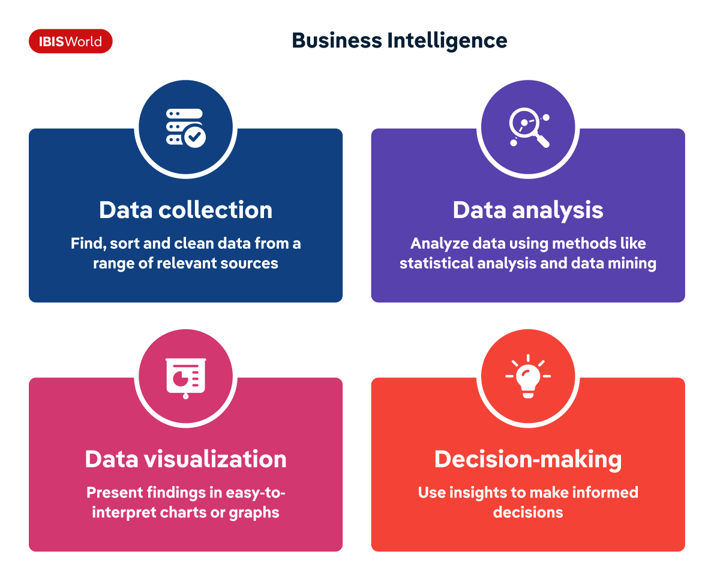Key takeaways:
Use business intelligence (BI) to make informed business decisions by collecting, analyzing and visualizing data.
Drive operational efficiencies by leveraging BI insights to quickly adapt to market changes and optimize resource allocation.
Incorporate BI successfully by setting clear objectives, prioritizing quality data and fostering a data-driven culture.
Getting the right information at the right time is crucial to making sound decisions. That’s where BI comes in. Unlike big data, which refers to the sheer volume of data, BI is about leveraging strategies and advanced technologies to dissect this data effectively. It provides key insights into your operations, markets and customers, enabling your business to make well-informed decisions.
What is business intelligence?
BI is a technology-driven process that involves analyzing business data to provide insights. Executives and managers use BI to make informed, data-driven decisions based on historical and current data. BI focuses on analyzing company data to improve operations, using various techniques such as data mining, process analysis, performance benchmarking and descriptive analytics. The process utilizes software that ingests this data and presents it in user-friendly formats such as reports, dashboards, charts and graphs. This process of converting your raw data into meaningful information allows you to strategize and make better operational choices.
How does business intelligence work?
BI consists of several interconnected processes including data collection, data analysis, data visualization and decision-making. Understanding how these components work will help you turn data into actionable insights, helping you make confident business decisions. Let’s break them down.
Data collection
In the first step, you’ll gather raw data from a multitude of diverse sources. These sources may include internal databases, transaction records, social media platforms, customer feedback and market research reports. The goal is to collect as much relevant information as possible to provide a solid foundation for your analysis. The data is then cleaned and converted into a format suitable for analysis.
Data analysis
Once you’ve collected your data, you’ll need to thoroughly analyze it. This process involves utilizing a wide range of tools and techniques to explore the data, such as statistical analysis and data mining. The goal is to identify patterns, trends, irregularities and relationships within the data. Machine learning algorithms are regularly used here to help uncover valuable insights.
Data visualization
The next step is to present your findings in a visual format. This involves creating charts, graphs, or other visual representations of data that make complex information more digestible. These visualizations make it easier for you to evaluate the data, understand the data at a glance and draw conclusions about your business.
Decision-making
The ultimate goal of BI is to facilitate informed and timely decision-making. Employing data-driven approaches helps minimize the risk of errors while enhancing operational efficiency. Use the insights you gained through your data analysis and visualization to make strategic decisions with greater confidence.

Business intelligence vs. business analytics vs. business process analysis
BI, business analytics (BA) and business process analysis (BPA) share some characteristics, but are each separate processes. Broadly speaking, business intelligence looks at past and present data to shape decisions about your business’s current operations. Business analytics, on the other hand, uses tools to make predictions about future performance to drive strategies for business growth. Business process analysis specifically focuses on reviewing and optimizing the internal processes that keep your business running day to day.
Why does business intelligence matter?
Understanding the advantages of BI allows you to move away from guess-work and formulate strategies based on factual data, improving your business’s overall performance. It can help with:
- Informed decision-making: When you base your decisions on data, you’re acting on facts, not assumptions. This means your choices are grounded in reality, giving your business a solid foundation to build upon.
- Maintaining a competitive advantage: You can position your business for success by identifying trends before your competitors. Leveraging data doesn’t just keep you in the game, it puts you ahead of it.
- Operational efficiency: Data can reveal inefficiencies in your processes that you might not have noticed. Optimize these areas and you can save time, reduce costs and focus your resources where they’re needed most.
- Risk management: Data also helps you foresee potential risks and challenges. This allows you to prepare and respond effectively, safeguarding your business from unexpected setbacks.
- Customer insights: Use business intelligence to gain valuable insights into your customers’ behavior, preferences and needs. This enables you to deliver personalized experiences, fostering customer loyalty and driving revenue.
Tips for incorporating business intelligence
Incorporating BI into your strategic planning can seem like a daunting task. Keep these tips in mind to make the process smooth sailing.
Define clear objectives
Set clear objectives to better align your BI strategy with your overall business goals. The first step is to define what you hope to achieve. Are you looking to improve operational efficiency? Do you want to enhance customer satisfaction? Or perhaps you’re aiming to gain a competitive edge?
Prioritize data quality
The insights you gain from BI are only as good as the data you feed into it, so it’s essential to ensure the quality of your data. Make sure you develop robust data collection and management processes to maintain accuracy and consistency for the best results.
Foster a data-driven culture
To cultivate an environment that embraces a data-driven culture among your team, integrate BI software into your operational framework to instill a data-driven culture. Prioritize the utilization of BI insights for decision-making to ensure that your team relies on specific data points and analytics, rather than guesswork or intuition.
Regularly review and adapt
Continuously evaluate your BI initiatives to ensure they remain aligned with your business objectives. Be prepared to make necessary adjustments to accommodate shifting market trends and changing business needs. Keep an eye on emerging technologies and industry best practices to make sure you’re getting the most out of your BI processes. This proactive approach will help you stay ahead of the curve and maximize the value of your BI investments.
How does business intelligence help teams?
BI provides a platform where all team members can access and share data. This facilitates better collaboration, fostering an environment where everyone is working towards shared goals with the same information. For instance, your sales team can share insights with your marketing team to tailor campaigns that resonate with target audiences more effectively. Moreover, your teams no longer need to rely on gut feelings or instinct. Instead, they have access to data-driven insights that enable them to make informed decisions.
Your team can also use BI to identify bottlenecks and inefficiencies, improving workflows and increasing productivity. Your customer service team might use BI to identify peak call times and adjust staffing levels accordingly, ensuring efficient handling of customer queries. Additionally, with access to real-time data and insights, your team members are better equipped to perform their roles. They can proactively identify opportunities and challenges, making them feel more empowered and engaged.
BI also encourages continuous learning and improvement by providing objective performance data. Your team can review their performance, learn from successes and mistakes and continuously strive to improve. For example, your operations team could leverage BI data to assess the efficiency of a newly implemented customer support system and make appropriate refinements.
Selecting the ideal business intelligence solution
Incorporating BI into your business involves weighing up different software solutions. When doing so, it’s important to consider a few factors:
- Ease of use: Look for platforms that are user-friendly and intuitive with a clean interface and straightforward navigation. Remember, the goal is to simplify data interpretation, not complicate it.
- Integration capabilities: Your chosen platforms should seamlessly integrate with your existing systems. This ensures that your data flows smoothly from one platform to another, providing your business with timely and accurate insights.
- Scalability: As your business grows, your data requirements will too. Opt for solutions that can scale with your needs, allowing you to add more data sources or users as necessary.
- Security: Protecting your data should be a top priority. Ensure the platforms you choose have robust security measures in place, including data encryption and user authentication.
- Support and training: A good provider will offer comprehensive support and training to help you maximize the benefits of their platform. This could include tutorials, webinars or even a dedicated support team.
Final thoughts
BI integrates technology and strategy to help your business make informed decisions by transforming raw data into actionable insights. By embracing BI, your business can navigate the complexities of your industry, adapt to changing trends and take positive steps towards your goals.
Source from IBISWorld
Disclaimer: The information set forth above is provided by ibisworld.com independently of Alibaba.com. Alibaba.com makes no representation and warranties as to the quality and reliability of the seller and products.








